There are two environments to consider when composing – the digital environment and the performance environment. The performance environment is the area of the intended performance. This can be a venue (either inside or outside) or even a pair of headphones. It is where the composer intends their audience or listener to be located.
The digital environment is unseen and uninhabitable as it is a concept rather than a physical space. Sounds that need to travel through loudspeakers in order to be heard come from the digital environment and audio manipulations made using software happen in the digital environment.
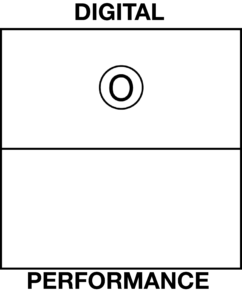
In the S.O.A.P. diagrams, these environments are shown as two boxes: digital on top and performance underneath This hierarchical positioning implies that sounds existing in the digital environment need to travel down through loudspeakers into the performance environment in order to be perceived by the listener.[26] The presence of such sounds is illustrated by the letter ‘O’ for objects in the digital environment section. This, for example, is where all of the sounds in acousmatic music originate.
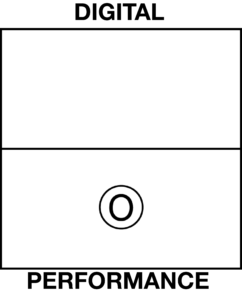
Of course, not all sounds in music are spawned in the digital environment. Sounds made by acoustic instruments or other non-amplified means are created in the performance environment. In such instances, an ‘O’ will be in the bottom box. More traditional forms of music such as string quartets or orchestral music are produced in the performance environment.
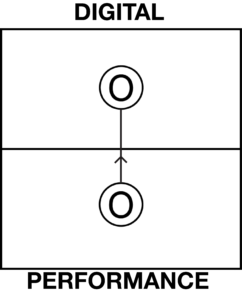
In instances where sounds produced in the performance environment are taken through a microphone and amplified through the loudspeakers, we need to ask a question: do I intend for my audience to hear the unamplified sound as well? If the answer is yes, an ‘O’ will be placed in each box. This treats the amplified sound as a separate object from the original, acoustic source. A connecting line signifies that the object in the performance environment is causing the object in the digital environment. If the answer is no, then there will be no ‘O’ in the performance environment. Just as objects can exist in both the digital and performance environments, so too can all other aspects of S.O.A.P.. I will go into more detail on these connecting lines of influence in section 2.7..
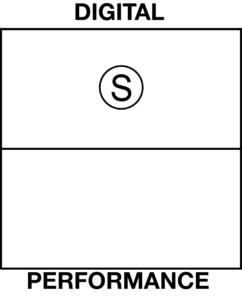
Space is a parameter for composition in the digital environment since the composer can add reverberation or make a sound appear very close or far away in order to create different spatial impressions. The composer can also pan the sound to play with the orientation of the listener. Space in the digital environment will always be present in the case of recorded sounds because it is an inevitable byproduct of the recording process. Recorded sounds will inherently carry the spatial signature of where they were recorded, even if it is imperceptible to the human ear. They will also carry their positioning to the microphone – whether the sounding object was placed near or far, to the left, to the right or straight on. Even synthesised sounds have space-evoking attributes. This can be in the form of a sound’s ADSR trajectory or in any synthetic reverberation, equalisation or delay. This type of space shows as an ‘S’ in the upper box.
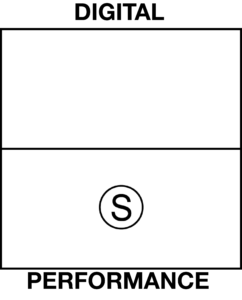
As it is an inherent characteristic of the real world, space is always present in the performance environment. Acoustics unavoidably affect the sound during its travel from the source to the listener’s ears, even in a soundproofed space. This is still true for compositions for headphones – even though the space in between the speakers and the ear of the listener is small, it still exists. Space also takes into consideration the orientation and proximity of the listener to the sounds they are hearing and thus the performance medium influences the listener’s perception of space. Whether the composer uses a multichannel system or a stereo pair of speakers affects how the sound arrives at the listener. Does the composer make use of surround sound or are the sounds all emanating from one location? Since neither the acoustics or positioning of the sound source(s) to the listener can be removed from the performance of the composition, we cannot separate sound from the spatial signature of the performance environment.
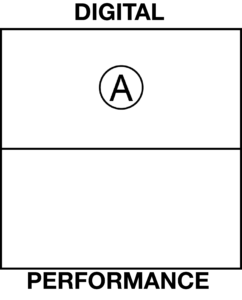
Agency in the digital environment can be a more complicated matter. There are many instances where an agent might be perceived and it is difficult to know whether the audience will experience the piece as you intend them to. To combat inconsistencies such as this, the S.O.A.P. framework encourages the composer to illustrate how they hope the audience will experience their piece. Whether the audience will have that same experience that the composer intends is a separate matter and one that will vary from piece to piece. There can be a number of ways to evoke a sense of agency in the digital environment (represented by an ‘A’ in the top box). An audiovisual piece with a person on screen is perhaps the most concrete way of evoking agency in the digital environment. Other examples could include using voices or source-bonded sounds of a clear action such as in Bearing Zero, YinYang, and the opening of Lines. A weaker sense of agency may be evoked through using sounds with a strong gestural quality such as the middle and end sections of Lines.
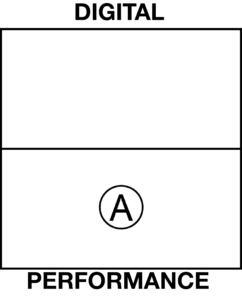
When a physical performer is present, they can be shown as an ‘A’ in the performance environment. A performer playing an instrument or otherwise creating sound evokes a strong sense of agency, especially when the performer is visible to the audience. Even a performer typing at a laptop gives a sense of agency if the listener believes they are impacting the performance.
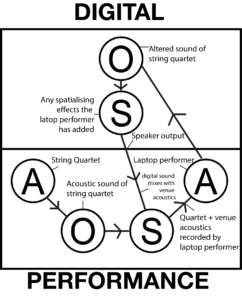
How to illustrate agency can start to become somewhat complicated when dealing with multiple performers. In instances such as those, I think about the different impacts the performers are having and the different types of agency present. If several performers are influencing the audience’s experience in similar ways, I group them into one ‘A’ representing their collective agency. Examples of this could be a standard string quartet or even a whole orchestra. If, for example, a string quartet were being sampled live by a fifth person at a laptop, this person’s agency would require a second ‘A’ as they are having a different impact on the performance.
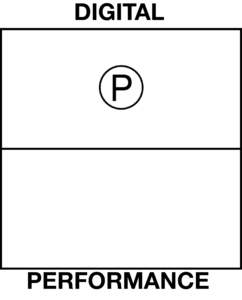
Place has similar issues to agency in regards to subjectivity. To arouse a recognition of a place in the listener requires the listener to already have some experience of the exact location or the type of location. Again, whether the composer intends for their listeners to experience a sense of place will dictate whether a ‘P’ appears in the diagram. If the composer intentionally uses a place-evoking soundscape that is played through loudspeakers, then a ‘P’ should be shown in the digital environment. Similarly, a sense of place could come from a visual aspect such as a video recording of a location. The evocation of place can range from vague to strong with a video reference or distinct sound mark providing the strongest ties to place (such as in 57N), and more generic sounds such as traffic, bird song, or the ocean providing a weaker tie (such as in Sounds of the Silent City).
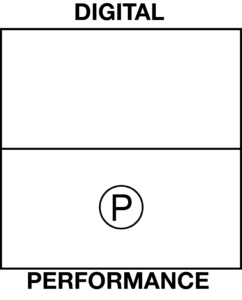
It is relatively uncommon to find compositions where the place is significant in the performance environment, apart from in works designed for performance at a specific location. While performances almost always happen in a venue, this location does not often have an impact on the sound itself aside from the acoustics (taken into account in the element of space). Cognitively, we can separate the performance from the venue and view the venue as merely a means for delivering the art. However, sometimes the venue can have significance to the composition. Many site-specific installations can only happen in specific locations, for example, Vocal Resonances (2018) by Kathy Hinde[27] and The Hummingbird Clock (2016) by Lawrence Abu Hamdan[28]. My composition, 57N, is an example of a site-specific work, though the piece can be adapted to suit many venues.
[26]The role of the listener and their implied position in the diagram will be discussed in section 2.6..
[27]Kathy Hinde, Vocal Resonances (Leicester, 2018).
[28]Lawrence Abu Hamdan, The Hummingbird Clock (Liverpool, 2016).
